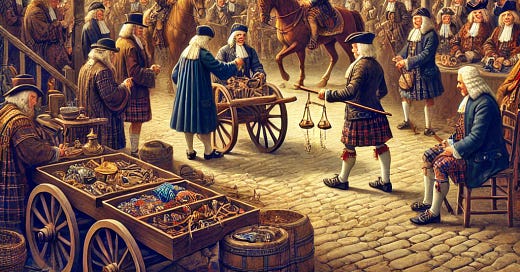In the bustling marketplaces of medieval Scotland, before the rise of permanent shops and modern commerce, the country relied heavily on itinerant merchants known as chapmen. These traveling traders played a crucial role in connecting remote villages and towns with goods, news, and even culture from the outside world.
The chapmen were not just lone wanderers selling trinkets from their packs; they were part of an organized and highly respected merchant society that wielded influence in Scotland’s economic and social life. The Society of Chapmen, officially recognized by King James V in the 16th century, provided structure, rules, and a sense of brotherhood among its members. These merchants had their own traditions, annual meetings, and even a form of self-regulation that kept their trade fair and orderly.
One of their most famous gatherings took place alternately in Dunkeld and Coupar Angus, where the chapmen held a formal court and engaged in traditional festivities, ensuring both business and entertainment thrived in equal measure.
A Day in the Life of a Chapman
Before delving into their annual gatherings, it is important to understand the life of a chapman. These merchants were highly mobile traders who traveled from village to village, carrying a variety of goods such as cloth, ribbons, household items, jewelry, books, and even medicines. Some chapmen specialized in certain products, while others acted as general traders, offering whatever was in demand.
Their work was challenging—Scotland’s rugged terrain and unpredictable weather meant long, difficult journeys. Often, chapmen traveled in small groups for safety, as lone traders were vulnerable to bandits and highwaymen.
Despite the dangers, chapmen were valued members of society, bringing not only goods but also news, gossip, and entertainment to isolated communities. Many were excellent storytellers, sharing tales from other towns to captivate their customers.
The Annual Gatherings: Court, Commerce, and Celebration
Each year, the Society of Chapmen held an official meeting, alternately hosted in Dunkeld and Coupar Angus. These gatherings, often referred to as "the Court," served multiple purposes:
1. Official Business and Self-Regulation
Chapmen were required to attend these meetings if they wanted to continue trading under the Society’s protection. The court was held to ensure that all chapmen:
Maintained fair trading practices
Paid their dues to the Society
Used standardized weights and measures
Each member was required to present their measuring equipment to be compared with official standards. This practice prevented dishonest trading and ensured that customers received fair quantities of goods.
To enforce attendance, an official of the Society went through the marketplace, collecting either a small piece of merchandise or a fine of 2s. 6d from each chapman who failed to appear in court. This was a strict but effective way of maintaining order and participation.
2. The Festivities: Riding at the Ring
Once the official business was concluded, the chapmen indulged in traditional games and competitions, the most famous being "Riding at the Ring."
In this event, two wooden posts were erected with a crossbeam from which a small ring was suspended. Mounted on horseback and armed with a pointed rod, each chapman had to gallop at full speed and try to catch the ring with their rod.
This game was a nod to medieval jousting tournaments and tested the dexterity and skill of the chapmen, many of whom were excellent horsemen. The winner was celebrated and awarded a prize, sometimes in the form of fine cloth, silver trinkets, or even an honorary title within the Society.
The famous ballad "He was a braw gallant, and he rode at the ring" immortalized this competition, and it remained a highlight of the chapmen’s gatherings for generations.
3. Feasting and Bonding
Following the games, the chapmen gathered for a grand feast. Food and drink flowed freely, with traders exchanging stories of their travels, discussing trade routes, and forming alliances.
The Society of Chapmen was not just a business network; it was a brotherhood, ensuring that members had each other’s support on the road. New members were often initiated during these feasts, swearing loyalty to the Society and its rules.
The Decline of the Chapmen
The Society of Chapmen flourished for centuries, but as Scotland modernized, their role began to fade. By the 19th century, several factors led to their decline:
The rise of permanent shops in villages and towns reduced the need for traveling merchants.
Improved transportation, such as railways and better roads, allowed goods to be transported more efficiently by wholesalers.
Industrialization and urbanization meant that people had better access to products without relying on itinerant traders.
Despite their disappearance as a formal group, the spirit of the chapmen lived on. Their legacy can be seen in the tradition of traveling salespeople, street vendors, and even modern market fairs, which continue to bring goods and entertainment to communities in Scotland and beyond.
Legacy and Cultural Impact
While the Society of Chapmen is no longer active, their influence remains in Scottish folklore, songs, and historical traditions. The "Riding at the Ring" competition is still remembered, and many towns celebrate their market days with fairs that echo the gatherings of the chapmen.
Moreover, their impact on commerce cannot be overstated. The ethics of fair trade, standardized measures, and merchant networks that they established laid the groundwork for modern retail practices.
The chapmen may have vanished from the roads of Scotland, but their legacy remains woven into the country’s history—a testament to the resilience, ingenuity, and adventurous spirit of these traveling merchants.





